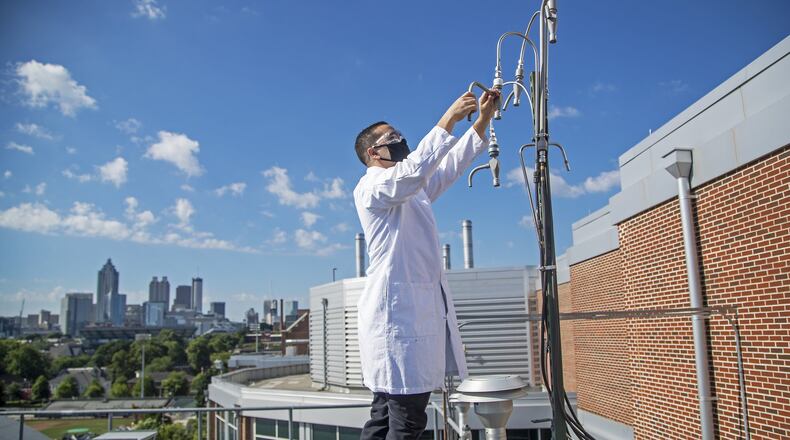On a typical, smoldering hot Atlanta day sans a pandemic, drivers are sitting in the infamous metro traffic anxiously waiting to arrive at their destination — it’s a wait that brings smog and poor air quality.
But in recent weeks, Atlanta’s air quality has measurably improved – a trend attributed to the coronavirus pandemic, which forced many inside their homes to wait for the outbreak to slow.
Historically, Atlanta has ranked among the most congested cities in America, but the state’s order closing non-essential businesses and public places changed that. “We saw traffic pretty much go from terrible to nonexistent in a week or two after the shelter-in-place order,” WSB Skycopter anchor Doug Turnbull said.
Turnbull said at the height of the shutdown there were 40% to 50% fewer cars on road compared to a year ago in April 2019. In recent weeks, he’s seen a slight uptick as Gov. Brian Kemp has eased restrictions.
With so few cars on the roads, Atlanta has had only one smog alert for the year and has maintained good air quality, according to AirGeorgia.org. Last year, Atlanta had three smog alerts through June 10, and 18 for the entire season from April 1 to Oct. 31, according to the Georgia Department of Natural Resources.
Since the pandemic, particle pollution in Atlanta has been well below the 2017 to 2019 average, according to raw data from Georgia Department of Natural Resources. Particle pollution, or particulate matter, is a mixture of solid and liquid droplets suspended in the air, small enough to be inhaled and cause lung damage.
Since April 15, particle pollution has been between 5 and 15 micrograms per cubic meter — lower than the 2017 to 2019 average maximum concentration, which was between 10 and 20 micrograms per cubic meter.
RELATED: Atlanta smog alerts: Understanding Code red, Code orange
Since April, researchers at Georgia Tech have been studying how fewer cars on Atlanta’s streets has affected the air quality in Midtown.
“The pandemic is devastating in many ways and levels but from the air quality perspective, the shutdown is a valuable experiment on how fewer emissions will affect the overall air quality,” said Nga Lee “Sally” Ng, associate professor at Georgia Tech’s School of Chemical & Biomolecular Engineering and School of Earth & Atmospheric Sciences.
Ng’s team set up a measurement station on the roof of the department’s building on the Midtown campus to measure the city’s air quality. Since April, the team has seen a decrease in nitrogen dioxide levels, consistent with the decrease in cars on the roads.
Traffic has already begun to return as restrictions have been gradually lifted. Ng said they’ve captured the early part of Georgia’s reopening, but are still doing measurements to detect when the pollution begins to climb again. “We hope to measure until the Midtown area reopens so we can capture the air quality change.”
The last week of April, had a few “slow zones here and there,” said Turnbull, who writes the Gridlock Guy column for The Atlanta Journal-Constitution about Atlanta’s traffic. Now that June has arrived, he said, “Absent of wrecks, we are starting to see just a few non-crash-related delays in the p.m. (afternoon) drive. It shows people are running errands in the day as opposed to the morning.”
Raw data from the Georgia Department of Natural Resources indicates Atlanta’s ozone level saw a significant drop around March 23 – a week before the statewide shelter in place was issued. Atlanta’s air quality also improved around that time.
During that time, ozone levels were about 20 parts per million compared to 60 parts per million for the 2017 to 2019 average maximum concentration. Ozone is a colorless, odorless gas beneficial in the earth’s stratosphere, where it absorbs incoming ultraviolet solar radiation that could harm life on Earth. But near the surface, ozone is a secondary pollutant that can damage lungs.
Atlanta saw a brief uptick in ozone levels May 2, when the city had a code orange smog alert, but ozone levels have steadily declined since May 4.
“The trends are showing decreasing concentrations in ozone and particle pollution, especially during mid-March and much of May,” State Climatologist Bill Murphey said.
Georgia Tech assistant professor Jennifer Kaiser leads another research team that tests how fewer planes have affected the air quality near Hartsfield-Jackson International Airport, dubbed the world’s busiest airport.
The total number of flights at Hartsfield-Jackson International in April declined 73% in April compared with the same month in 2019, according to the airport’s monthly air traffic report. The Atlanta airport handled 20,406 flights in April 2020, down from 75,669 in April 2019.
“We’re not at peak ozone season yet. Typically, it’s in the summer when we have the worst air quality. So it will be interesting to see if we have worse air quality days in that season,” said Kaiser, who works in Georgia Tech’s Civil and Environmental Engineering and Earth and Atmospheric Sciences school.
But even with decreased road and air traffic, Murphey said weather should also be considered when discussing the air quality. Rainy days help wash out the pollution. Murphey said March and April were wet months for Atlanta, with each month picking up at least 2 inches above normal rainfall.
“The conditions weren’t conducive to poor air quality, due to the number of rain events along with windy conditions,” he said. “This is the fourth wettest period, year to date, for Atlanta at 36.29 inches.”
Murphey said hot, dry, sunny, stagnant summer-like days under the influence of a strong high pressure system are most conducive to ozone formation.
Regardless of weather, Atlanta’s improved air isn’t likely to last. As the slow reopening continues, the air will change again. But not before air researchers log more data.
Ng hopes her team’s research helps others better understand what sources are contributing to Atlanta’s air quality.
“I think when this is all said and done, once we can analyze the data, it will be useful for formulating pollution control strategies.”
About the Author
Keep Reading
The Latest
Featured




